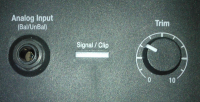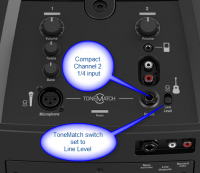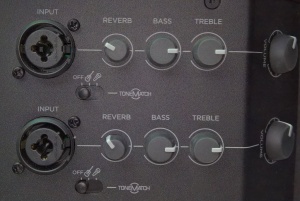Difference between revisions of "Balanced vs Unbalanced"
m |
m (→Confusion Plugs and Jacks) |
||
| Line 12: | Line 12: | ||
</div> | </div> | ||
| − | == Confusion Plugs and Jacks == | + | == Confusion About Plugs and Jacks == |
[[File:Headphone TRS Stereo.jpg|thumb|100px|Headphones with Tip-Ring-Sleeve plugs]][[File:14 to xlr male.jpg|thumb|100px|1/4 inch (6.3 mm) Tip-Ring-Sleeve to XLR]][[File:14 insert.jpg|thumb|100px|Insert cable]] | [[File:Headphone TRS Stereo.jpg|thumb|100px|Headphones with Tip-Ring-Sleeve plugs]][[File:14 to xlr male.jpg|thumb|100px|1/4 inch (6.3 mm) Tip-Ring-Sleeve to XLR]][[File:14 insert.jpg|thumb|100px|Insert cable]] | ||
| Line 21: | Line 21: | ||
* Insert (send and return) | * Insert (send and return) | ||
| − | Whether or not a cable with a {{1/4 TRS}} plug is stereo or balanced (mono) or an insert cable depends on how it is being used and the electronic interfaces at both ends of the connection. | + | Whether or not a cable with a {{1/4 TRS}} plug is stereo or balanced (mono) or an insert cable depends on how it is being used and the electronic interfaces at both ends of the connection. |
| − | |||
== Connections to Bose Portable PA Systems == | == Connections to Bose Portable PA Systems == | ||
Revision as of 07:43, 16 May 2019
Introduction
Stereo, Mono, Balanced, Unbalanced are terms that refer to applications (how a cable is being used).
XLR, Tip-Ring-Sleeve, Tip-Sleeve are terms that refer to connections (the physical connectors at the ends of the wires and how those wires are attached to the connectors).
It's important to use the correct connections to support your application or you may end up with poor results. For example, if you connect a stereo signal to a balanced input, you may hear very little, or just effects with none of the original signal.
Confusion About Plugs and Jacks
One source of confusion is that a cable with a 1/4 inch (6.35 mm) Tip-Ring-Sleeve jack on one end may be used for several applications (examples)
- Stereo headphones (left and right sides of a stereo signal)
- Mono balanced connection (hot and cold signals)
- Insert (send and return)
Whether or not a cable with a 1/4 inch (6.35 mm) Tip-Ring-Sleeve plug is stereo or balanced (mono) or an insert cable depends on how it is being used and the electronic interfaces at both ends of the connection.
Connections to Bose Portable PA Systems
T4S ToneMatch mixer
- Channels 1, 2, 3, 4 XLR inputs are balanced.
- Channels 1, 2, 3, 4 ¼ inch (6 mm) jacks are balanced
- They will accept 1/4 inch (6.35 mm) Tip-Sleeve jack Tip-Sleeve connections and the connections will be unbalanced.
- Channels 5 and 6 are balanced, but will accept 1/4 inch (6.35 mm) Tip-Sleeve jack Tip-Sleeve.
If you use a 1/4 inch (6.35 mm) Tip-Ring-Sleeve from a balanced source, the connection will be balanced.
If you use a 1/4 inch (6.35 mm) Tip-Ring-Sleeve from an unbalanced source, the connection will be unbalanced.
If you use a 1/4 inch (6.35 mm) Tip-Sleeve from a balanced or unbalanced source, the connection will be unbalanced.
If you have a balanced source then using a balanced connection (XLR or 1/4 inch (6.35 mm) Tip-Ring-Sleeve) is preferable.
T8S ToneMatch mixer
- Channels 1, 2, 3, 4, 5, 6, 7, 8 XLR inputs are balanced.
- Channels 1, 2, 3, 4, 5, 6, 7, 8 ¼ inch (6 mm) jacks are balanced
- They will accept 1/4 inch (6.35 mm) Tip-Sleeve jack Tip-Sleeve connections and the connections will be unbalanced.
- Channels 9 and 10 are balanced, but will accept 1/4 inch (6.35 mm) Tip-Sleeve jack Tip-Sleeve.
If you use a 1/4 inch (6.35 mm) Tip-Ring-Sleeve from a balanced source, the connection will be balanced.
If you use a 1/4 inch (6.35 mm) Tip-Ring-Sleeve from an unbalanced source, the connection will be unbalanced.
If you use a 1/4 inch (6.35 mm) Tip-Sleeve from a balanced or unbalanced source, the connection will be unbalanced.
If you have a balanced source then using a balanced connection (XLR or 1/4 inch (6.35 mm) Tip-Ring-Sleeve) is preferable.
T1 ToneMatch Audio Engine
- Channels 1, 2, 3 XLR inputs are balanced.
- Channels 1, 2, 3 1/4" jacks are unbalanced (but will accept 1/4 inch (6.35 mm) Tip-Ring-Sleeve) the connections are still unbalanced.
- Channels 4/5 are balanced, but will accept ¼ inch jack Tip-Sleeve.
If you use a 1/4 inch (6.35 mm) Tip-Ring-Sleeve cable from a balanced source, the connection will be balanced.
If you use a 1/4 inch (6.35 mm) Tip-Ring-Sleeve cable from an unbalanced source, the connection will be unbalanced.
If you use a &1/4 inch (6.35 mm) Tip-Sleeve cable from a balanced or unbalanced source, the connection will be unbalanced.
If you have a balanced source then using a balanced connection (XLR or ¼ inch jack Tip-Ring-Sleeve) is preferable.
L1 Model II
- Model II Power Stand Analog input is balanced.
It will accept ¼ inch jack Tip-Sleeve.
If you use a 1/4 inch (6.35 mm) Tip-Ring-Sleeve cable from a balanced source, the connection will be balanced.
If you use a 1/4 inch (6.35 mm) Tip-Ring-Sleeve cable from an unbalanced source, the connection will be unbalanced.
If you use a ¼ inch jack Tip-Sleeve from a balanced or unbalanced source, the connection will be unbalanced.
If you have a balanced source then using a balanced connection (XLR or ¼ inch jack Tip-Ring-Sleeve) is preferable.
L1 Model 1S
- Model II Power Stand Analog input is balanced.
It will accept ¼ inch jack Tip-Sleeve.
If you use a 1/4 inch (6.35 mm) Tip-Ring-Sleeve cabe; from a balanced source, the connection will be balanced.
If you use a 1/4 inch (6.35 mm) Tip-Ring-Sleeve cable from an unbalanced source, the connection will be unbalanced.
If you use a 1/4 inch (6.35 mm) Tip-Sleeve cable from a balanced or unbalanced source, the connection will be unbalanced.
If you have a balanced source then using a balanced connection (XLR or ¼ inch jack Tip-Ring-Sleeve) is preferable.
L1 Compact
Compact Channel 2 1/4 inch (6.35 mm) Tip-Ring-Sleeve input is balanced.
It will accept 1/4 inch (6.35 mm) Tip-Sleeve cables.
If you use a 1/4 inch (6.35 mm) Tip-Ring-Sleeve cable from a balanced source, the connection will be balanced.
If you use a 1/4 inch (6.35 mm) Tip-Ring-Sleeve cable from an unbalanced source, the connection will be unbalanced.
If you use a 1/4 inch (6.35 mm) Tip-Sleeve cable from a balanced or unbalanced source, the connection will be unbalanced.
If you have a balanced source then using a balanced connection (XLR or 1/4 inch (6.35 mm) Tip-Ring-Sleeve cable) is preferable.
S1 Pro System
S1 Pro Combo Inputs 1/4 inch (6.35 mm) Tip-Ring-Sleeve jack and XLR are balanced.
They will accept 1/4 inch (6.35 mm) Tip-Ring-Sleeve or 1/4 inch (6.35 mm) Tip-Sleeve jacks.
If you use a 1/4 inch (6.35 mm) Tip-Ring-Sleeve cable from a balanced source, the connection will be balanced.
If you use a 1/4 inch (6.35 mm) Tip-Ring-Sleeve cable from an unbalanced source, the connection will be unbalanced.
If you use a 1/4 inch (6.35 mm) Tip-Sleeve from a balanced or unbalanced source, the connection will be unbalanced.
If you have a balanced source then using a balanced connection (XLR or 1/4 inch (6.35 mm) Tip-Ring-Sleeve) is preferable.
References
Unbalanced vs. Balanced Lines - Whirlwind
Interconnection of Balanced and Unbalanced Equipment Bill Whitlock, Jensen Transformers.
Sound System Interconnection RaneNote 110
Balanced, Unbalanced, Stereo? what are they? Sweetwater.com > Frequently Asked Questions
Balanced vs Unbalanced Interconnects audioholics.com
What's the Difference Between Balanced and Unbalanced aviom.com







